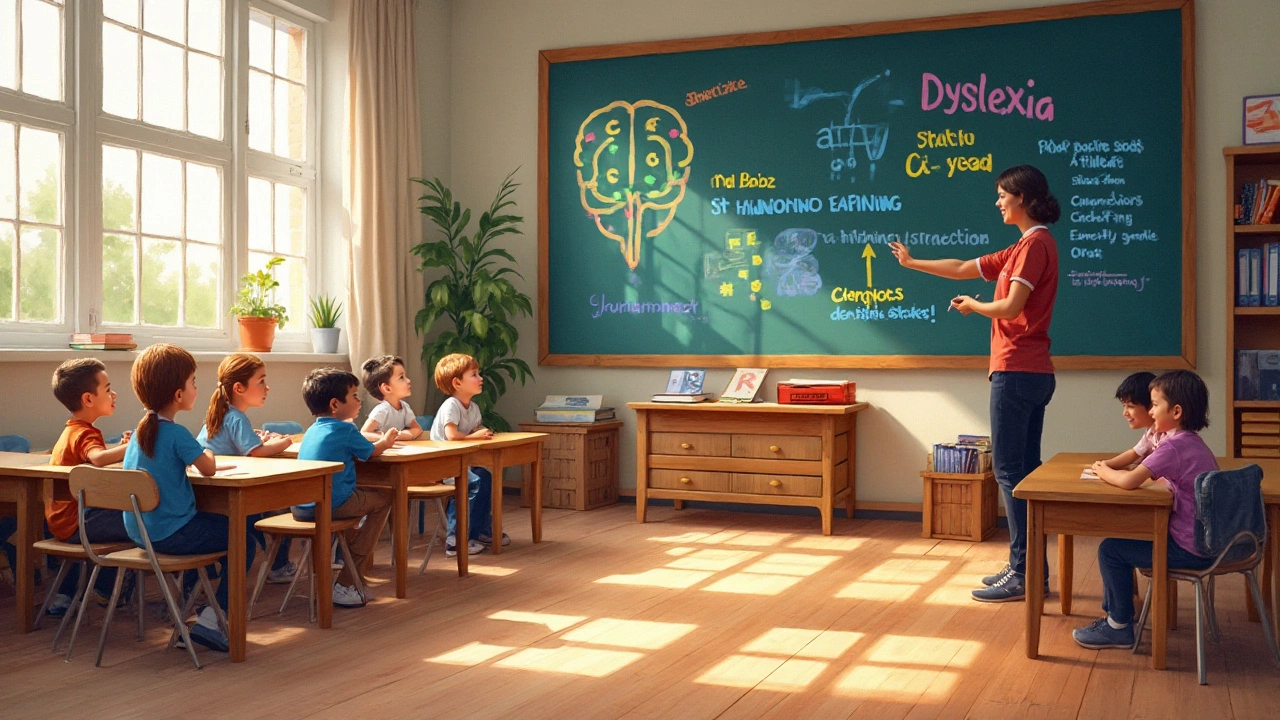-
31
- 0

Understanding Dyslexia: The Common Learning Disability
Dyslexia, often identified as the most common learning disability, touches the lives of countless individuals around the world. It is a specific learning disorder that primarily affects one's ability to read, posing unique challenges in academic settings and day-to-day life. While it can lead to difficulties with decoding words and reading fluency, it's vital to recognize that with the right support, individuals with dyslexia can thrive.
As awareness grows, so does our understanding of dyslexia – revealing not just its challenges but also the potential for creative and strategic thinking often found in those who manage it. This article serves as a guide for understanding dyslexia, identifying its signs, and exploring effective strategies that can empower educators and parents to provide the best support with confidence and understanding.
- Understanding Dyslexia
- Signs and Symptoms
- Causes and Diagnosis
- Effective Teaching Strategies
- Support and Resources
Understanding Dyslexia
Dyslexia is a lifelong condition that touches nearly 5 to 10 percent of the population, making it the most common of all learning disabilities. At its core, dyslexia affects the brain's ability to process language. While it is largely understood as a reading difficulty, its impact goes deeper, often affecting spelling, writing, and sometimes even speaking. The struggle with reading stems from problems identifying the sounds associated with letters and spelling patterns, sometimes referred to as phonemic processing difficulties. These challenges can lead to frustration in academic settings, where the ability to read fluently and with comprehension is often assumed. Yet, it is important to note that dyslexia bears no reflection on one's intelligence; many individuals with dyslexia are creative thinkers and possess great potential.
Historically, dyslexia was misunderstood and often attributed to a lack of effort or motivation. However, advances in research have begun to unravel much of the mystery surrounding it. According to the Yale Center for Dyslexia & Creativity, dyslexia is most accurately defined as “an unexpected difficulty in reading in an individual who has the intelligence to be a much better reader.” The condition has gained significant recognition and advocacy, leading to better resources and support systems. Advocates continue to work to dismantle the stigma and myths, ensuring that people with dyslexia receive the understanding and accommodations they require to succeed. This progress is significant, but the journey is ongoing as awareness needs to reach all corners of the educational world.
Recent studies using advanced imaging technology have shed light on how the brains of people with dyslexia process words and language differently. For example, differences have been observed in the way in which information is transmitted between the brain's left and right hemispheres. This neurological evidence supports the idea that dyslexia is rooted in the unique ways the brain functions, underscoring that it cannot be equated with laziness or lack of aptitude. Furthermore, some experts suggest that alongside difficulties, individuals with dyslexia often show strengths such as enhanced problem-solving abilities in real-world situations.
“Dyslexia is not a disease. It's a lifelong condition that describes the way the brain is wired,” says Dr. Sally Shaywitz of the Yale Center for Dyslexia & Creativity. Dr. Shaywitz's insights continue to inspire change in both societal perception and educational practices.
It is crucial for educators, parents, and society to shift from a deficit-focused perspective to one that recognizes and celebrates the strengths and unique contributions of individuals with dyslexia. Literacy interventions, personal tutoring, and technology aids like text-to-speech software are invaluable tools that can greatly enhance the learning experience. Developing confidence in skills and abilities, separate from reading challenges, is equally important in supporting those with dyslexia. With ongoing support and adaptations, dyslexia need not be a barrier to personal and professional success. Continuing the conversation and spreading awareness remains key in nurturing environments where children and adults alike can thrive.
Signs and Symptoms
Dyslexia often emerges early in an individual's learning journey, but its signs and symptoms can be subtly elusive to untrained eyes, sometimes masquerading as mere challenges that children face in school. Although every person with dyslexia is unique and may experience different symptoms, a common theme exists where difficulty with accurate and fluent word recognition becomes apparent. In young learners, this may look like trouble learning the names of letters or the alphabet, and in more pronounced cases, struggles with basic phonetic skills. As these children grow, these early signs may evolve, leading to more significant challenges with reading comprehension and the retention of new vocabulary.
Interestingly, dyslexia impacts more than just reading; it has a broad, multi-dimensional effect that sometimes influences speech and language development. Children might jumble up words or even find it challenging to articulate certain sounds or syllables correctly. According to the International Dyslexia Association, around 15-20% of the population exhibit some of the symptoms of dyslexia, which includes spelling difficulties and trouble linking letters to sounds. Such statistics underscore the need for early intervention, as acknowledging these symptoms in their incipient stages can lead to more effective management adaptations.
Parents and educators may also notice that children with dyslexia have unexpectedly immaculate listening skills. Their verbal communication might be exceptional despite their reading hurdles. A typical observation is the deep frustration these children feel, often due to the harsh self-judgment they cast upon their perceived inadequacies. "I could read the word just a moment ago, but now it's gone," is a phrase echoed in households and classrooms, hinting at dyslexia's precarious nature.
"Dyslexia is not a sign of low intelligence, by any means. In fact, many people with dyslexia are very bright, and their brains just process language differently, which can be an advantage in creative tasks" - Dr. Sally Shaywitz.
The symptoms adults face, who might have grown up undiagnosed, can be more varied because coping strategies often mask the core reading difficulties. These adults may avoid tasks that require extensive reading or writing outright. Organizational skills become a particular highlight, as compensation for decoding challenges often borders on meticulousness in planning. Yet, the reading barriers remain, largely unchanged from their childhood strife. Consequently, recognizing these signs isn't just beneficial for children; adults too can find solace and assistive solutions once they identify and embrace their reality.
Recognizing these signs is important, especially given the prevalence of the condition. By focusing on reading difficulty and honing in on dyslexia through behavioral observations and open conversations, key interventions and support systems can be tailored. It facilitates not only better academic performance but also bolsters self-esteem and personal growth. Provided with the tools for success, individuals with dyslexia can tap into their innate abilities and creativity, which often goes unparalleled.

Causes and Diagnosis
Dyslexia has been a topic of extensive research over the years, yet the exact causes remain somewhat elusive. The prevalent belief among experts is that dyslexia stems from differences in brain structure rather than any issues related to intelligence or vision. These neurological differences, often inherited from family lines, affect areas involved in key language processing. Genetics play a significant role, as studies show dyslexia tends to run in families. Researchers have pinpointed specific genes linked to reading processes, highlighting the genetic underpinning of this condition.
While looking deeper into the brain’s anatomy, scientists have observed variations in the size and function of areas responsible for language. Individuals with dyslexia exhibit less connectivity between regions of the brain that process language, which can affect phonemic awareness—a critical skill in learning to read. Advanced imaging technology has aided this discovery, offering glimpses into the unique neural pathways of those living with dyslexia. Interestingly, many individuals with dyslexia have superior visual-spatial skills, suggesting that these brain structure differences can also come with their own unique advantages.
Diagnosis presents its own set of hurdles, as it requires a nuanced understanding of a person's educational and familial background. According to the International Dyslexia Association, “The diagnosis of dyslexia involves an extensive evaluation that includes cognitive, family, and educational history, as well as reading, language, and intellectual assessments.” These assessments help experts distinguish dyslexia from other learning challenges, ensuring appropriate intervention strategies are employed.
Typically, teachers are the first to notice signs of dyslexia, since they observe children’s daily interaction with reading and writing. A common indicator is a significant discrepancy between a child’s verbal intelligence and their literacy skills. However, formal diagnosis is undertaken by trained specialists who utilize a battery of tests to evaluate reading and language abilities, often informed by academic records and psychological assessments. Early diagnosis is crucial as it opens the door to early intervention, which is instrumental in addressing learning gaps before they widen.
One of the primary challenges in diagnosis lies in the diverse manifestation of dyslexia symptoms. While one person might struggle with phonemic awareness or the ability to break down words into their component sounds, another might face challenges in comprehension or the speed of reading. This variability necessitates a comprehensive and individualized approach to diagnosis. Specialists frequently adopt a multi-dimensional method to get a fuller picture of how dyslexia impacts the individual, leading to a more targeted support strategy.
Parents and guardians play a pivotal role in the process as well. They need to communicate closely with educators and specialists to stay informed about the best practices and interventions available. Family support can significantly alleviate the potential frustration and anxiety stemming from difficulties in school. Collaboration among teachers, specialists, and families can create a nurturing environment conducive to learning and growth for those with dyslexia. While the journey of diagnosis and intervention may be complex, understanding the causes and signs plays a key role in supporting individuals with dyslexia to reach their fullest potential.
Effective Teaching Strategies
For educators and parents, tackling the challenges posed by dyslexia requires a mix of patience, creativity, and dedication. At the heart of helping those with reading difficulty lies understanding that every individual learns differently and at their own pace. Tailored and effective teaching strategies can bridge the gap between frustration and successful learning. Acknowledging that learning disability doesn’t mean lack of intelligence is pivotal. This insight lays the foundation for personalized educational approaches that can significantly improve learning experiences.
One key strategy is the multisensory approach, which engages more than one sense at a time to enhance memory and learning. This method combines visual, auditory, and kinesthetic-tactile pathways simultaneously to reinforce learning of words and concepts. By integrating eye-catching visuals with sounds and hands-on activities, students with dyslexia can better grasp complex information, making learning more inclusive and engaging. Experts often advocate for structured literacy programs that provide cumulative and systematic learning of language structures, enhancing reading fluency.
In modern classrooms, technology offers valuable tools in supporting diverse learning needs. Text-to-speech software, audiobooks, and speech recognition can transform written texts into auditory experiences, easing reading burdens for dyslexic learners. As highlighted by the International Dyslexia Association, these technologies can serve as powerful allies for struggling readers. "Technology doesn’t just provide a way to manage a learning disability," said a spokesperson for IDA, "It can make reading engaging and accessible, leveling the playing field for all students."
Classroom accommodations can also play a crucial role. Teachers should consider offering alternative ways for students to complete assignments or demonstrate knowledge. Extended time on tests, oral exams, or opportunities for verbal presentation of ideas can help overcome challenges with written language. It’s essential that the learning environment nurtures confidence and minimizes anxiety, encouraging a growth mindset and resilience.
The collaboration between parents, teachers, and specialists forms a supportive network that significantly influences students' progress. Regular communication and cooperation ensure consistency in teaching methods and expectations both at home and school. Having regular feedback sessions can aid in monitoring progress and adjusting strategies as needed. The importance of fostering an inclusive and understanding environment that promotes self-esteem and motivation cannot be overstated.
Lastly, professional development for educators is invaluable. Continuous training on the latest research and strategies in special needs education empowers teachers to meet their students’ unique needs effectively. Awareness and understanding of dyslexia and other learning disabilities will only grow as more educators become equipped with the skills necessary to support their students. By implementing these effective teaching strategies, educators can unlock potential and pave the way for their students' achievements, with or without a learning disability.

Support and Resources
Providing support and resources for individuals with dyslexia is a multi-faceted approach that involves educators, parents, and the community. The journey begins with awareness and understanding, as these are crucial in transforming the educational experience for dyslexic learners. It's undeniable that the right support can propel an individual from struggling to thriving. Schools play a pivotal role by implementing evidence-based teaching strategies tailored specifically for learning disabilities. These can include multi-sensory instructional approaches that engage visual, auditory, and kinesthetic learning modalities to enhance comprehension and retention. Additionally, assistive technologies like audiobooks, text-to-speech software, and dyslexia-focused apps are becoming invaluable tools that cater to diverse learning needs.
For parents, being equipped with knowledge is empowering. Engaging in open dialogue with educators to ensure a coordinated plan is vital. Parents can access myriad resources, such as non-profit organizations dedicated to empowering individuals with dyslexia. These organizations frequently provide workshops, counseling, and training sessions that equip families with strategies to aid their child's learning journey. Advocating for an Individualized Education Program (IEP) or a 504 Plan in schools can also ensure adaptations are tailor-made to accommodate the unique needs of their child.
Moreover, community networks offer invaluable support. Local support groups or online forums provide spaces where parents and individuals can share experiences, advice, and encouragement. This collective knowledge bank not only brings comfort in shared experiences but often leads to discovering new resources. Many practitioners and parents alike have seen firsthand the power of community and the positive impact it can have.
Statistics and Insights
An insightful perspective highlights a significant milestone: around 85% of struggling readers are more successfully supported when special needs education programs are implemented early, according to the International Dyslexia Association. These findings emphasize the importance of timely intervention. Schools and parents working together can change the trajectory for young learners, opening doors to future possibilities and achievements previously thought unattainable. Highlighted here is an appropriate quote from a respectable source that embodies the journey many experience:
"Dyslexia is not a disease, it is a community-built experience of learning to navigate the world differently." - Oliver Holmes, Educational Advocate
For educators, professional development and training in recognizing and addressing reading difficulties can pave the way for inclusive classrooms. Initiatives that promote awareness and equip educators with tools to differentiate instruction, understand student needs, and implement strategic interventions are more crucial than ever. Ultimately, the goal is collective understanding and acceptance, which leads to the creation of inclusive learning environments where students with dyslexia can flourish.
By embracing each student's unique abilities and leveraging available resources, we build paths to success that extend beyond the classroom. Schools, homes, and communities that foster an environment of empathy, understanding, and tailored support are ensuring a brighter future for those with dyslexia. In closing, the integration of these practices and resources paves the way for lifelong learning and achievement.
Write a comment
Tags Weight
- education
- exam preparation
- study tips
- adult education
- online courses
- adult learning
- lifelong learning
- distance learning
- GCSE revision
- online education
- private tutoring
- special needs education
- scholarships
- remote learning
- scholarship tips
- financial aid
- international students
- effective learning
- e-learning
- education funding

Written by Elara Winslow
View all posts by: Elara Winslow